|
Report
from
Europe
European economies his bottom but unlikely to bounce back any
time soon
The European economy may finally be exiting its longest post-war
recession but entering a period of stagnation or very weak growth at
best, latest data suggest.
The purchasing managers index (PMI) for the euro zone rose to a 15-month
high of 48.9 in June. Germany's PMI rose 0.7 point to 50.9, signalling
modest growth. France's score also rose but remained below 50.
PMI scores of below 50 signal falling business activity, so even June's
improved reading points to a slight drop in euro-zone activity in the
second quarter.
The PMI suggests that any recovery in coming months will be too weak to
halt the rise in unemployment in Europe or to alleviate the region's
public and private debt burdens.
However, the PMI also suggests that, following a 0.9% (annualised) fall
in euro-zone GDP in the first quarter of 2013, the pace of economic
contraction probably slowed in the second quarter. Unemployment across
the euro-zone is still at 12.2% and is expected to rise for the rest of
this year.
The pace of job-cutting accelerated in June, according to the PMI survey,
despite the overall improvement in business sentiment.
Other surveys of business sentiment and industrial production have been
more upbeat. According to the European Commission, euro-zone consumer
confidence rose close to a two-year high in June, though it remained
well below its long-term average.
Overall, the signs are that recovery in Germany is trickling down to
other large economies in the region including France, Italy and Spain.
The hope among many Europeans is that stronger global demand will spur
growth in export-sensitive Germany, which accounts for around 30% of
euro-zone GDP. That, in turn, may boost exports from its European
neighbours and provide an overall boost to business confidence.
But no-one is expecting a rapid turnaround. There are very significant
downside risks. Still-worsening joblessness will continue to push up
spending on unemployment and other benefits in Spain, France and Italy.
Small businesses continue to struggle against high borrowing costs. The
lack of spending by businesses and consumers will hamper tax receipts.
Without expanding economies, debt burdens will keep on rising as a share
of GDP, even if annual budget deficits decline.
The region remains very vulnerable to potential shocks, such as an
economic slowdown in China which would seriously dent a vital source of
export demand for European products.
Meanwhile the euro recently hit six-month highs against a broad basket
of currencies. This has been a boon to wood importers, encouraging a
slight uptick in purchases to boost depleted stocks. However, the strong
euro, if it persists, spells trouble for the region¡¯s exporters. A major
concern when European domestic consumption is so weak.
European construction forecastsrevised once again
The downturn in European construction has been deeper and continued
for much longer than expected, but it should finally hit bottom during
2013. This was the conclusion of the Euroconstruct network of European
construction forecasters at their June 2013 conference.
Euroconstruct revised its expectations for the construction market in
the 19 member countries (Austria, Belgium, Czech Republic, Denmark,
Finland, France, Germany, Hungary, Ireland, Italy, Netherlands, Norway,
Poland, Portugal, Slovakia, Spain, Sweden, Switzerland, UK) in 2013 to a
decline of 3% ¨C deeper than the 2.5% decrease it forecast at the end of
last year.
The outlook for Europe¡¯s construction output in 2014 has also changed,
from expected growth of 1% to an increase of just 0.5%. Growth for 2015
of 1.7% is currently forecast.
The strongest forecast declines in construction output in 2014 are
expected in Spain (-7.7%) and Portugal (-3.5%), while the largest
increases are predicted for Norway (4.6%) and Sweden (3.5%). In terms of
sectors, residential construction shows the most promise for a recovery
between now and 2015.
Output is expected to decline 2.2% this year before returning to 1.1%
growth in 2014, increasing to 2.3% in 2015.
But the outlook for non-residential construction and civil engineering
is weaker. Non-residential construction is expected to fall 3.3% this
year and a further 0.3% in 2014, before recovering to 1% growth in 2015.
Civil engineering output is expected to drop 3.5% this year before
returning to 0.4% growth in 2014 and 1.4% growth in 2015.
Tropical hardwood imports declining even further in 2013
European imports of tropical hardwood products have maintained their
downward trajectory this year. This trend is almost universal, affecting
all product groups and all major supply countries.
A large part of the explanation lies in broader economic trends which
continue to dampen down European consumption. However, lack of lack of
supply has also been a factor during 2013.
This is due to political and infra-structure problems in parts of
central Africa, numerous mill closures, reductions in log harvests, and
diversion of logs and lumber to other more buoyant markets elsewhere,
notably China.
Another contributing factor may have been enforcement of the EUTR from
3rd March 2012 which has placed new demands on EU importers to seek
evidence from all suppliers that there is negligible risk of any wood
being derived from an illegal source.
This is increasing procurement focus on the relatively limited number of
exporters offering certified and independently verified tropical wood.
It is too early to assess the full impact of this measure, but it may be
significant that total EU import of tropical logs, sawn, veneer and
plywood was around 12% higher in the January-February 2013 period
(281000cu.m), immediately before EUTR enforcement, than in the
March-April 2013 period (243000cu.m).
In previous years, EU imports of tropical wood in the first four months
of the year tend to be distributed more evenly.
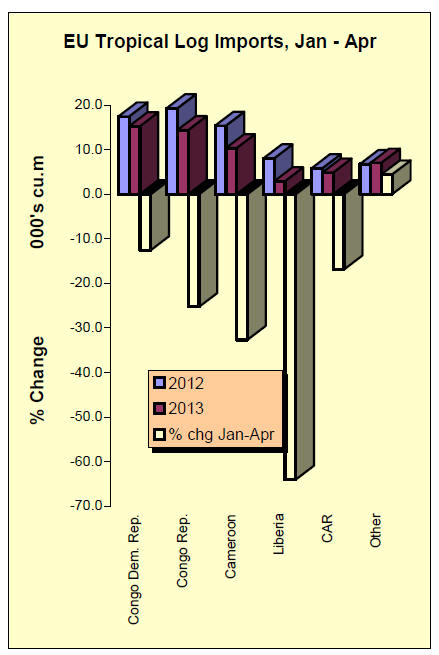
During the first four months of 2013, EU27 imports of tropical hardwood
logs were only 55,000 cu.m, 25% less than the same period in 2012.
Imports fell without exception from all the main supply countries,
including Congo DR, Congo Republic, Cameroon and Liberia.
Due to strong Asian demand for logs and tightening controls on log
exports by African countries, prices have been high relative to sawn
lumber offering little incentive to European buyers to import logs.
Europe¡¯s formerly large plywood manufacturing sector based on tropical
logs appears to be fading fast.
EU imports of sawn tropical hardwood were 296,000 cu.m in the first 4
months of 2013, 20% less than in 2012. After falling below 1 million
cu.m for the first time in 2012, EU imports of sawn tropical hardwood
are unlikely to exceed 900,000cu.m in 2013.
Imports slowed considerably from Cameroon, Malaysia, Brazil and Ivory
Coast during the four month period, but increased from Gabon.
In recent years, declining EU imports of sawn tropical lumber have been
partially offset by rising imports of hardwood mouldings and glulam from
developing countries. However sales of those commodities into the EU
have also been hard hit by the continuing recession.
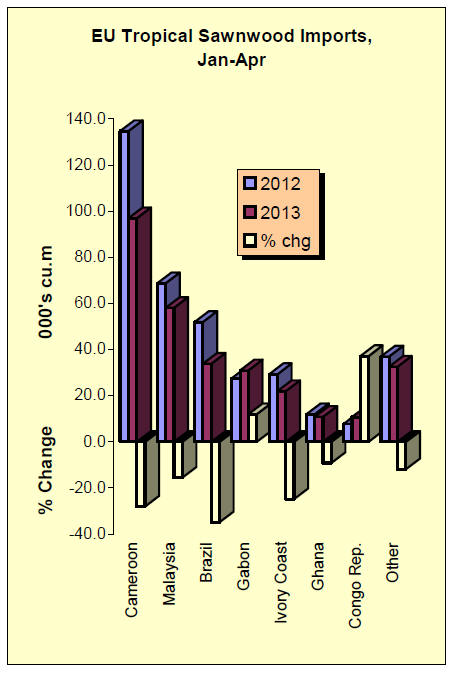
During the January to April period, total imports of hardwood mouldings
and glulam fell 27% and 17% respectively.
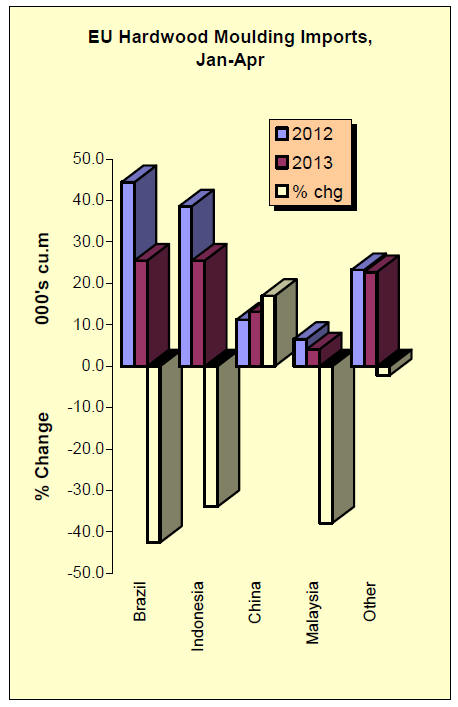
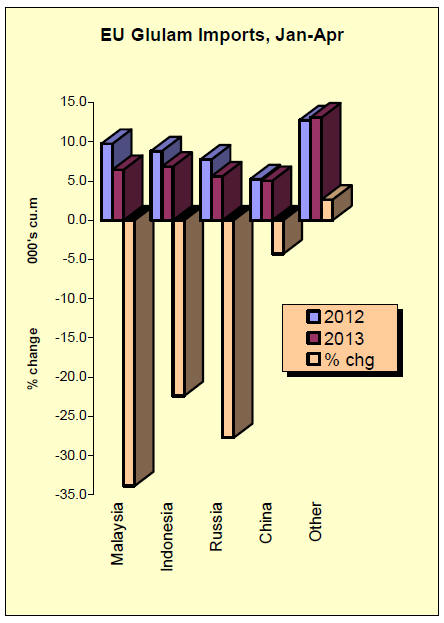
There were large falls in imports of these commodities from Malaysia,
Indonesia and Brazil. However, there was a 17% rise in EU imports of
hardwood mouldings from China to 13000cu.m.
EU imports of tropical hardwood veneer were down 24% at 78,000 cu.m in
the first 4 months of 2013, with imports well down from Gabon, Ivory
Coast, and Cameroon.
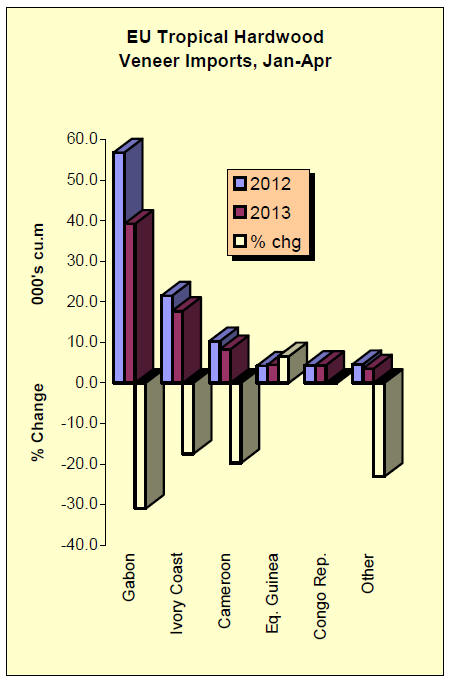
During the same period, EU imports of plywood faced with tropical hardwood
declined 7%. However, in this instance, the decline was mainly
attributable to China and Gabon, while Indonesia and Malaysia regained
some market share in the first 4 months of 2013.
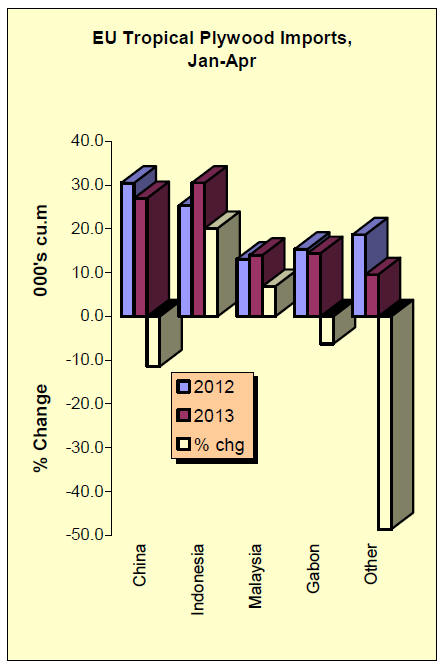
Losing share to European and other temperate hardwoods
In addition to loss of volume, the data indicates that tropical
hardwood is losing share of the EU¡¯s declining market. The downturn in
EU imports of hardwood sawn, plywood and veneer during 2012 and the
first four months of 2013 was more pronounced for tropical wood than it
was for non-tropical wood.
Data just released by the European Organization of Sawmillers (EOS) also
shows that production of sawn hardwood in EOS member countries (Austria,
Belgium, Denmark, Finland, France, Germany, Italy, Latvia, Norway,
Romania, Sweden, Switzerland, UK) was rising in 2012 at a time when
European imports of this commodity were falling.
According to EOS, European sawn hardwood production increased 8.2% to
6.22 million cu.m in 2012. Production increased strongly in Romania,
with other lesser gains in Austria, Belgium, France and Italy. EOS
forecast a further increase in production in 2013, but at a slower rate
of 1.2%.
This suggests that imported hardwood has been losing market share
relative to domestically harvested wood.
Despite production growth in 2012, Europe¡¯s hardwood sawmilling sector
still faces major challenges. Exports of hardwood logs to countries
outside Europe are impacting on the sector, especially in France,
Belgium and Germany.
Production in 2012 was 20% less than peak levels of 7.7 million cu.m in
2006 and 2007. Seven hardwood processing businesses with a combined
cutting capacity of 300,000 cu.m per year were forced to close or file
for insolvency in Germany and France between 2011 and June 2013.
Nearly 200,000 cu.m of this capacity was a single Germany-based beech
sawmill. In a highly competitive market, these sawmills were unable to
cover rising log costs by increasing the price of lumber.
However these closures in central Europe are being partially offset by
rising production capacity in Eastern Europe, notably in Romania.
Oak further consolidates flooring sector dominance
According to the Federation of European Parquet Industry (FEP), wood
flooring production in the 17 FEP countries: Austria, Belgium, Czech
Republic, Denmark, Finland, France, Germany, Hungary, Italy,
Netherlands, Norway, Poland, Romania, Slovakia, Spain, Sweden, and
Switzerland declined 4.7% to 68.3 million m2 in 2012.
This compares to peak levels of over 100 million m2 in 2007. Production
increased in Austria, Belgium, Germany and Poland during 2012. However
these gains were offset by big losses in several areas including
Hungary, Italy, Spain, Scandinavia, and Switzerland.
In 2012 oak accounted for close to 70% of all flooring produced by FEP
Members, up from 67% in 2011. During the same period, production of
tropical wood flooring fell from 7.4% to 6.2%.
Since 2008, oak¡¯s share has risen from 58% and tropical wood¡¯s share has
fallen from 14.7%. Ash and beech accounted for 6.5% and 6.1%
respectively of flooring production in 2012 and share of these species
has remained stable over the last 5 years. Maple and cherry are still
out of fashion in Europe and accounted for only 2% and 1% of flooring
production in 2012 respectively.
* The market information above has been generously provided by the
Chinese Forest Products Index Mechanism (FPI)
¡¡
|